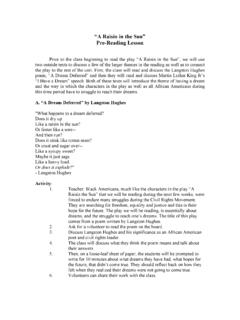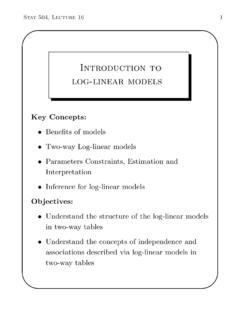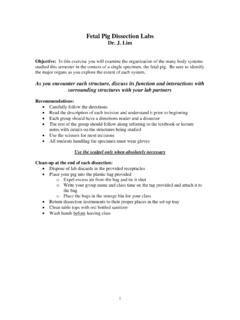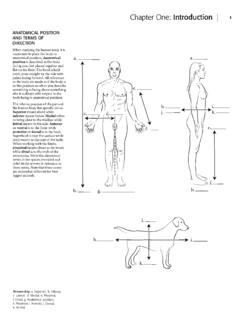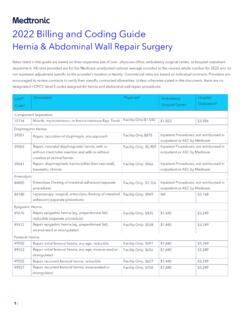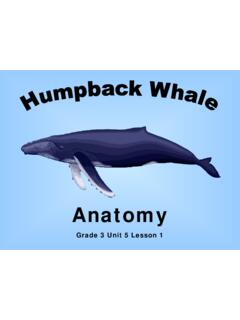Transcription of Dissection of the Spiny Dogfish Shark – Squalus acanthias ...
1 D. Sillman; 7/17/2009 Dissection of the Spiny Dogfish Shark Squalus acanthias Biology 110 Penn State New Kensington (D. Sillman - adapted from Laboratory Studies in Integrated Zoology by Hickman and Hickman) Classification Phylum Chordata, Subphylum Vertebrata, Class Chondrichthyes (cartilagenous fishes) The class Chondrichthyes includes the sharks, rays, skates and chimaeras and is characterized in part by having a skeleton made of cartilage instead of bone. Most fish belong to the class Osteichthyes (bony fish skeletons made of bone). The sharks are very generalized vertebrates and are large enough to dissect fairly easily, making them a popular choice for introductory vertebrate Dissection .
2 Dogfish sharks are marine and are common along both the Atlantic and Pacific coasts. They grow to about 1 m in length, live 25-30 years, and are omnivorous (eating both plant and animal matter). External structure (Refer to Figures 1 and 2 on p. 5) The body is divided into the head (anterior to the pectoral fins), trunk (from pectoral fins to pelvic fins), and tail. The fins include a pair of pectoral fins (anterior), which control changes in directions during swimming; a pair of pelvic fins, which serve as stabilizers and which in the male are modified to form claspers used in copulation; two median dorsal fins, which also serve as stabilizers; and an asymmetrical caudal (tail) fin.
3 Th e Spiny Dogfish is so named for a pair of spines immediately anterior to each dorsal fin. These spines are often removed from Dissection specimens as they are mildly poisonous! Identify the mouth with its rows of teeth (modified placoid scales), which are adapted for cutting and shearing; two ventral nostrils, which lead to olfactory sacs and which are equipped with folds of skin that allow continual in-and-out movement of water; and the lateral eyes, which lack movable eyelids but have folds of skin that cover the outer margin of the eyeballs. The part of the head anterior to the eyes is called the snout.
4 A pair of dorsal spiracles posterior to the eyes are modified gill slits that open into the pharynx. They can be closed by folds of skin during part of the respiratory cycle to prevent the escape of water. Five pairs of external gill slits are the external openings of the gill chambers. Insert a probe into one of the slits and notice the angle of the gill chamber. The pharynx is the region in back of the mouth into which the gill slits and spiracles open. A lateral line, appearing as a white line on each side of the trunk, represents a row of minute, mucus-filled sensory pores used to detect differences in the velocity of surrounding water currents, and thus to detect the presence of other animals, even in the dark.
5 Not e th e cloacal opening between the pelvic fins. This is a common exit for digestive and urinary waste, sperm from the male reproductive system and, in the female, the passageway through which the pups are born. Cloaca comes from the Latin word for sewer. The skin consists of an outer layer of epidermis covering a much thicker layer of dermis densely packed with fibrous connective tissue. The leathery skin is covered with placoid scales. Each scale has a wide base embedded in the skin and a spine that projects from the s u r f a c e pointing posteriorly. Run your hand over the skin, first from heat to tail, then back the other way to feel the projecting spines of the scales.
6 Th ese are very different than the scales of bony fishes. Placoid scales are actually similar in structure to teeth. The dark dorsal and light ventral coloration of the skin makes the Shark less conspicuous (Why? Think where the natural light is coming ). D. Sillman; 7/17/2009 Internal structure (Refer to Figures 3 7) Open the coelomic cavity by extending the mid- ventral incision caudally to just in front of the cloacal opening and cranially to just below the mouth. You will need to cut through the cartilage of the pectoral girdle between the pectoral fins. Now, make transverse cuts caudal to the pectoral fins and cranial to the pelvic fins to open the posterior part of the coelomic cavity.
7 Rinse out the body cavity. The body cavity is lined with parietal peritoneum, a shiny membrane tightly adhering to the inner surface of the cavity. Each organ in the body cavity is also covered with a tightly adhering membrane, called visceral peritoneum. These peritoneal membranes come together to form the double-membraned dorsal mesentery that supports the digestive tract. Digestive system Identify the large liver which is very rich in oil for energy storage. The liver has two large lobes and a small median lobe. Note the elongated greenish gallbladder, embedded in the median lobe. Move the liver aside to see the large esophagus, which leads from the pharynx to the J-shaped stomach.
8 Follow the stomach around the curve of the J an d l o c a t e a narrowing point; this is the pyloric valve, a muscular constriction between t h e stomach and the duodenum (the first part of the intestine). The pyloric valve controls the passage of food out of the stomach. Make a slit in the wall of the stomach and extend the cut upward into the esophagus. Remove and examine the contents of the stomach and then rinse it out to allow you to view the rugae (folds) within the stomach and the papillae lining the inner wall of the esophagus. What function do you think these inner structures serve? Next, find the 2 portions of the pancreas.
9 A small portion sits partially on the ventral surface of the duodenum, while a slender dorsal portion extends posteriorly to the large, triangular spleen (not a part of the digestive system). Finally, identify the valvular intestine, a s h o r t , wide tube which contains a spiral valve. Make a slit in the wall of the valvular intestine and open the tube enough to view the internal spiral valve. The spiral valve increases the surface area for absorption of nutrients in this very short intestinal tube. (How does the human intestine increase surface area?). The valvular intestine narrows into the colon, which empties into t h e cloaca.
10 Locate the long, thin rectal gland, dorsal to the colon. The rectal gland concentrates and excretes salt, important in osmoregulation. Urogenital system Although the excretory and reproductive systems have very different functions, they are closely associated structurally, and so are studied together. The k i d n e y s are long and narrow and lie behind the parietal peritoneum (human kidneys are also retroperitoneal ), one on each side of the midline of the dorsal body wall. These long, narrow kidneys extend from the pectoral girdle to the cloaca. Running along the surface of each kidney is a convoluted wolffian duct which (in females) carries the urine formed in the kidney to the renal papilla inside the cloaca for excretion.




